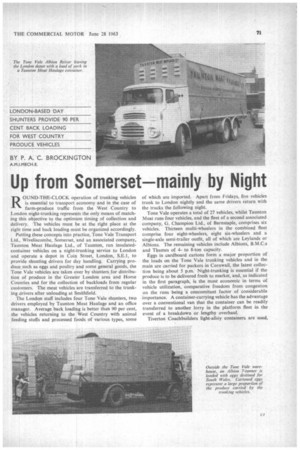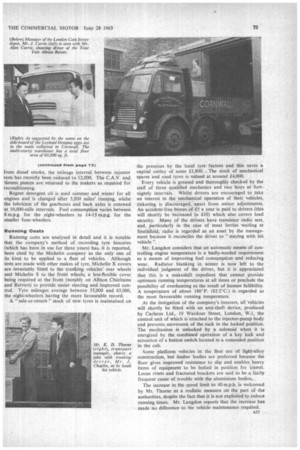Up from Somerset mainly by Night
Page 73

Page 74

Page 77

If you've noticed an error in this article please click here to report it so we can fix it.
ROUND-THE-CLOCK operation of trunking vehicles is essential to transport economy and in the case of farm-produce traffic from the West Country to London night-trunking represents the only means of matching this objective to the optimum timing of collection and delivery. The vehicles must be at the right place at the right time and back loading must be organized accordingly.
Putting these concepts into practice, Tone Vale Transport Ltd., Wiveliscombe, Somerset, and an associated company, Taunton Meat Haulage Ltd., of Taunton, run insulatedcontainer vehicles on a night-trunking service to London and operate a depot in Coin Street, London, S.E.1, to provide shunting drivers for day handling. Carrying produce such as eggs and poultry and some general goods, the Tone Vale vehicles are taken over by shunters.for distribution of produce in the Greater London area and Home Counties and for the collection of backloads from regular customers. The meat vehicles are transferred to the trunking drivers after unloading at Smithfield.
The London staff includes four Tone Vale shunters, two drivers employed by Taunton Meat Haulage and an office manager. Average back loading is better than 90 per cent, the vehicles returning to the West Country with animal feeding stuffs and processed foods of various types, some of which are imported. Apart from Fridays, five vehicles trunk to London nightly and the same drivers return with the trucks the following night.
Tone Vale operates a total of 27 vehicles, whilst Taunton Meat runs four vehicles, and the fleet of a second associated company, G. Champion Ltd., of Barnstaple, comprises six vehicles. Thirteen multi-wheelers in the combined fleet comprise four eight-wheelers, eight six-wheelers and a single-axle semi-trailer outfit, all of which are Leylands or Albions. The remaining vehicles include Albions, B.M.C.s and Thames of 4to 8-ton capacity.
Eggs in cardboard cartons form a major proportion of the loads on the Tone Vale trunking vehicles and in the main are carried for packers in Cornwall, the latest collection being about 5 p.m. Night-trunking is essential if the produce is to be delivered fresh to market, and, as indicated in the first paragraph, is the most economic in terms of vehicle utilization, comparative freedom from congestion on the runs being a concomitant factor of considerable importance. A container-carrying vehicle has the advantage over a conventional van that the container can be readily transferred to another lorry in the platform fleet in the event of a breakdown or lengthy overhaul.
Tiverton Coachbuilders light-alloy containers are used, having 2-in, of polystyrene insulation and are equipped with Dricold dry-ice packs that can maintain a consistent route temperature of 12-31'F., the higher temperature being applicable to meat and the lower temperature to ice cream. A fully refrigerated vehicle with the same make of body is included in the Taunton Meat Haulage fleet, which is equipped with Thermo-King refrigerating plant operated by a chassis-mounted petrol engine or from the mains. In this case the insulation has a thickness of 4 in.
Multi-Storey Warehouse
Adjoining the main workshops in Wiveliscombe, a multistorey warehouse has a floor area of about 60,000 sq. ft. and on the day of my visit the contents provided a good example of the multifarious activities of the companies. Although packaged eggs were the chief commodity in (very temporary) storage, the stock also included a large tonnage of collapsed cardboard cartons, cloth, tins of oil and grease and cartons of empty containers for a wide variety of retail produce. Vehicles are loaded and unloaded with the aid of power-operated elevator-conveyors, which are also used for internal movements.
A personal knowledge of the sources of traffic and of the goods carried on the part of the companies' staff and drivers has been an essential element in the successful development of the transport fleets, and it is therefore appropriate at this stage to give a brief history of Tone Vale Transport, which owes its existence to the myxomatosis scourge of 1955. In that year, B. A. Langdon and Sons Ltd., of Wiveliscombe, had rabbit-trapping rights covering a large number of farms in Somerset and Devon and handled an average of 12,000 rabbits a week, in addition to running an egg-packing and poultry business, and myxomatosis completely wiped out the trade in rabbits.
An Opportune Moment Corresponding with the denationalization of road transport, the time seemed opportune for entry into the roadhaulage industry to compensate for the loss of the rabbit business, and it was obviously appropriate to concentrate on the carriage of food produce and allied commodities, of which the Langdon family and staff had a detailed knowledge, in particular the provision of an efficient trunking service to London carrying eggs and poultry.
Founded by members of the Langdon family, Tone Vale Transport started operations in January, 1956, with two vehicles, and although today the concern is an independent undertaking, Mr. P. J. Langdon continues as managing director, and Mr. W. Langdon is in charge of the workshops. Transport manager of Tone Vale since the early days, Mr. R. D. Thorne works in close co-operation with Mr. T. Hewett, the manager of Taunton Meat Haulage, which has been operating for some three years.
The trunking vehicles average around 50,000 miles a year and some have covered more than 400,000 miles. Every type of overhaul is performed in the workshops and on average pistons and liners of the Leylands and Albions are renewed after 150,000 miles, heavy oil consumption being normally the deciding factor. The eight-wheelers have the best record and often cover over 200,000 miles before an overhaul is required.
Wellworthy, Al-Fin ring-insert-type pistons and Wellworthy liners are fitted as replacements. To ensure freedom from diesel smoke, the mileage interval between injector tests has recently been reduced to 12,000. The C.A.V. and Simms pumps are returned to the makers as required for reconditioning.
Regent detergent oil is used summer and winter for all engines and is changed after 5,000 miles' running, whilst the lubricant of the gearboxes and back axles is renewed at 10,000-mile intervals. Fuel consumption varies between 8 m.p.g. for the eight-wheelers to 14-15 m.p.g. •for the smaller four-wheelers.
Running Costs
Running costs are analysed in detail and it is notable that the company's method of recording tyre histories (which has been in use for three years) has, it is reported, been cited by the Michelin company as the only one of its kind to be applied to a fleet of vehicles. Although tests are made with other makes of tyre, Michelin X covers are invariably fitted to the trunking vehicles' rear wheels and Michelin S to the front wheels, a less-flexible cover being required at the front (notably on Albion Chieftains and Reivers) to provide easier steering and improved control. Tyre mileages average between 55,000 and 65,000, the eight-wheelers having the more favourable record.
A " sale-or-return" stock of new tyres is maintained on the premises by the local tyre factors and this saves a capital outlay of some £1,800. , The stock of mechanical spares and used tyres is valued at around £4,000.
Every vehicle is greased and thoroughly checked by the staff of three qualified mechanics and two boys at fortnightly intervals. Whilst drivers are encouraged to take an interest in the mechanical operation of their vehicles, tinkering is discouraged, apart from minor adjustments. An accident-free bonus of £5 a year is paid to drivers (this will shortly be increased to £10) which also covers load security. Many of the drivers have transistor radio sets, and, particularly in the case of meat lorries waiting at Smithfield, radiois regarded as an asset by the management because it reconciles the driver to "staying with his vehicle ".
Mr. Langdon considers that an automatic means of controlling engine temperature is a badly-needed requirement as a means of improving fuel consumption and reducing wear. Radiator blanking in winter is now left to the individual judgment of the driver, but it is appreciated that this is a makeshift expedient that cannot provide optimum running temperatures at all times or preclude the possibility of overheating as the result of human fallibility_ A temperature of about 180°F. (82.2°C.) is regarded as the most favourable running temperature.
At the instigation of the company's insurers, all vehicles will shortly be fitted with an anti-theft device, produced by Carlarm Ltd., 19 Wardour Street, London, W.1, the control unit of which is attached to the injector-pump body and prevents movement of the rack in the locked position. The mechanism is unlocked by a solenoid when it is energized by the combined operation of a key lock and actuation of a button switch located in a concealed position in the cab.
Some platform vehicles in the fleet are of light-alloy construction, but timber bodies are preferred because the floor gives improved resistance to slip and enables heavy items of equipment to be bolted in position for transit_ Loose rivets and fractured brackets are said to be a fairly frequent cause of trouble with the aluminium bodies.
The increase in the speed limit to 40 m.p.h. is welcomed by Mr. Thorne as a realistic measure on the part of the authorities, despite the fact that it is not exploited to reduce running times. Mr. Langdon reports that the increase has made no difference to the vehicle maintenance required.












































































































































